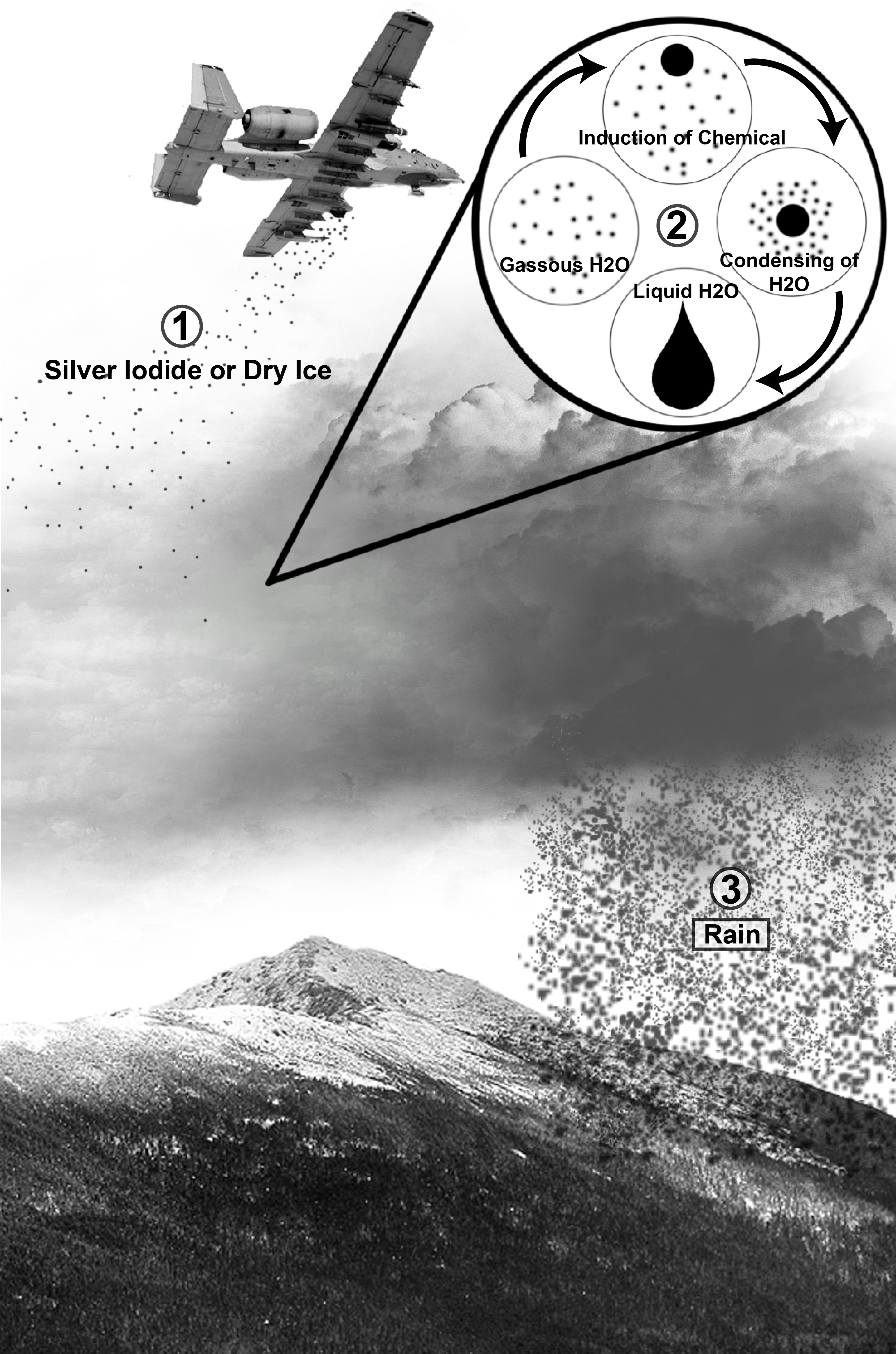In December 2021, an unusual story made the news. The Chinese government had reportedly used technology to produce unnatural rain and lower pollution and precipitation during a parade. The Chinese government is just one of the enthusiastic proponents of cloud seeding technology, with numerous countries and companies researching and already applying this type of technology.
But does it really work, and how could it be used?

Can artificial rainfall save our crops from droughts? The answer to this question has puzzled countless generations, but unlike previous times, when people appealed to gods or spirits, we may now have science as an ally.
The answer to these problems may be something called “cloud seeding”, a weather manipulation technique that can make the clouds rain (or snow) anytime and anywhere. Some reports suggest that rainfall or snowfall in a region can go up by 15% through cloud seeding. Moreover, scientists have been able to increase precipitation by up to 35% in some arid regions of the United Arab Emirates using the same technique.
At present, more than 50 countries in the world (including the US, Australia, China, UK, UAE, Germany, and Russia) employ cloud seeding (and other related methods) to deal with disturbed rainfall and water scarcity-related issues in their various dry regions. However, some scientists, environmental activists, and meteorologists also raise doubts about the authenticity, feasibility, and efficiency of this technique.
How does cloud seeding work?
To understand how cloud seeding works, we must first look at clouds and rain. Clouds are essentially made of water particles, appearing when there is too much water vapor for the air to hold. The vapor condenses and coalesces together into a cloud.
In the cloud, the droplets can grow — if they grow enough, they can fall down on the ground as rain. But in order to do this, they need to have a solid “seed”. This seed can be a speck of dust, pollen — or something artificial.
When cloud seeds are artificially introduced into the clouds to increase precipitation in a region, the process is called cloud seeding. The process is carried out either to produce rain on a given day, or to “dry” the clouds and prevent precipitation from occurring in days afterward.
American meteorologist Vincent Joseph Schaefer put forward the idea of creating artificial rainfall through cloud seeding in the year 1946. Since then, there has been a great deal of research into the techniques associated with cloud seeding.
Cloud seeding via silver iodide
The most common method of cloud seeding is the dispersion of salts like silver iodide in the air through aircraft or ground-based systems. When the dispersed microscopic particles of silver iodide come in contact with clouds (that are below the freezing point), they start behaving as condensation nuclei. The salt particles condense nearby water vapors and allow ice crystals in the clouds to grow further.

Moisture and water content are also drawn towards the growing ice crystals and as a result, the clouds become heavy, eventually, the ice crystals start melting in the form of cold rain. When precipitation occurs in clouds thatelectr have a temperature above zero degrees Celsius, the rain is considered warm. Also, the cloud seeding process employed in this artificial rainfall method is known as static seeding.
Electric cloud seeding
In 2017, a group of researchers at the UK’s University of Reading conducted a study on the use of electric charge to induce rainfall. The study revealed that electric shock can disbalance the charge within clouds and can turn the tiny water droplets inside them into large-size water droplets, the latter would come on the ground in the form of rainfall.
A couple of years later in April 2021, CNN reported that the United Arab Emirate’s National Center of Meteorology has awarded a $1.7 million grant to the scientists involved in the electric cloud seeding research. As part of the government’s rain-enhancement science-research program, the researchers will also conduct tests in UAE, based on their study. The report also suggests that during the tests, the cloud seeding team in UAE will use customized drones to give an electric shock to the clouds and make them rain. tech
“It is likely that charging cloud droplets on its own won’t replace established cloud-seeding techniques, but it could work alongside existing techniques to maximize the efficiency of cloud seeding,” said Dr. Keri Nicoli, Research Fellow at the University of Reading
In the initial tests conducted in July, researchers were able to successfully cause a rainstorm using the electric cloud seeding method. However, similar to other unconventional methods like laser cloud seeding, the technique is still under development and has a long way to go before it becomes as practical as salt-based cloud seeding.
Cloud seeding’s potential and problems
Cloud seeding is often deemed a harmless practice for humans and nature. Some reports even suggest that by the means of increasing rainfall at our will, this technology can allow us to inhabit deserts, improve agricultural production, elevate the standard of living among poor communities, and avoid adverse environmental conditions. Many a lost crops could have been saved if only it rained every now and then.
At present, the UAE government conducts hundreds of artificial rainfall missions every year to meet its precipitation demands. Many drought-affected states in the US are employing cloud seeding methods to overcome rainfall shortages. China owns the world’s largest cloud seeding system and uses the same to induce rainfall not just in dry regions but in its cities as well — and uses the technique to wash away air pollution for key social events.
However, many scientists believe that there is still not enough evidence to consider cloud seeding safe for our environment. For example, the use of silver iodide for conducting artificial rainfall is often condemned by many researchers because some studies suggest that it can cause harm to aquatic animals and microorganisms.
Another study indicates cloud seeding might reduce the risk of global warming, but at the same time, unregulated cloud seeding practices may lead to serious environmental issues such as ocean acidification, disturbed natural rainfall patterns, ecological imbalance, ozone depletion, etc.

It’s still not very clear just how well the technique works. A 2016 study did not find any statistically significant evidence to back up cloud seeding, with the study concluding that “it is difficult to show clearly that cloud seeding has a very large effect”. Commenting on these findings Rob Jackson, an ecologist at Stanford University, told C&EN that “you can squeeze out a little more snow or rain in some places under some conditions, but that’s quite different from a program claiming to reliably increase precipitation,” he says.
Still, China claims that using the cloud seeding method, the country successfully prevented rainfall in Beijing during the 2008 Olympics. Moreover, the US military is also said to have used million-dollar cloud seeding techniques to cause adverse weather conditions for the opposing army units during the Vietnam war — though such claims are very hard to verify.
Right now, it seems we’re at a stage where there is evidence that in some scenarios, cloud seeding can produce precipitation (when clouds are present). But whether this actually produces any significant long-term change, and whether it has use in agriculture or any other applications, still remains to be proven.
Even if it works, there are concerns that the technique could be weaponized. In the wrong hands, cloud seeding could be used to fuel floods or cause droughts at targeted locations.
Another major drawback of cloud seeding is that it is very expensive. For instance, the UAE government allotted a fund of $5 million during the first three years of its rain-enhancement science-research program. Every year the US government spends approximately $15 million on cloud-seeding activities, whereas China alone has an annual expenditure of more than $50 million on its numerous artificial rainfall-related projects. Did this money produce a good return on investment? Hard to say.
Artificial rainfall can not be seen as a permanent solution for droughts, climate change, and water-scarcity-related problems because cloud seeding has its own limitations and we are still unsure about its impact on our planet. We’re past the point where it was sci-fi technology — to an extent, we can make it happen now. We just don’t truly understand its long-term consequences — and perhaps, that is the scariest thing of all.


